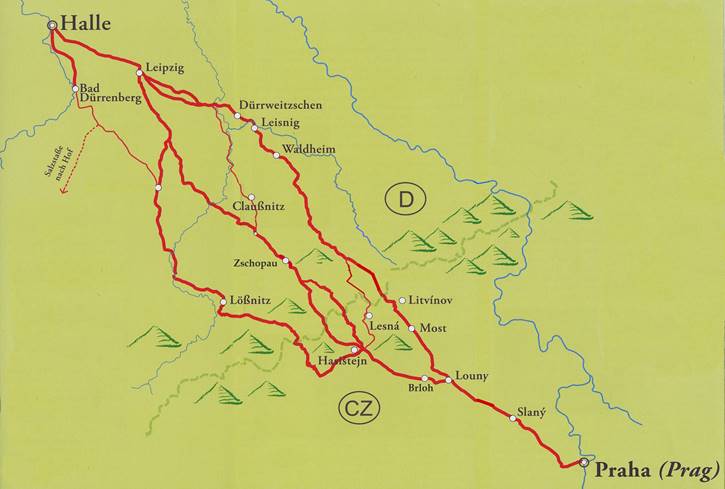Alte Salzstraßen im 14. – 16. Jahrhundert
Was für die heutige Wirtschaft das Erdöl und Erdgas sind, war vor 1000 Jahren das Salz für die Menschen. Die Einen wurden reich, Andere mussten sich in Abhängigkeit begeben. Heute durchziehen Erdöl- und Erdgasleitungen ganz Europa, früher waren die Salzstraßen die Lebensadern der Wirtschaft.
In Europa gab es vor 1000 Jahren viele Salinen, einige Salzbergwerke und unzählige Salzgärten an den Meeren, in denen Salz gewonnen wurde. Die meisten davon hatten jedoch nur lokale Bedeutung. Nur an wenigen Orten wurde für den Fernhandel produziert. Das waren in Mitteleuropa z.B. Lüneburg und Halle, die Region um Salzburg und einige Salzgärten an der Adria, sowie im östlichen Mitteleuropa das Salzbergwerk Wieliczka.
Diese Orte mit ihren Handelsplätzen Lübeck, Magdeburg, Leipzig, Prag, Salzburg, Venedig und Rom sollen mit einer neuen „kulturtouristischen Alten Salzstraße“, einer Ferien- und Panoramastraße, verbunden werden. Diese historische Alte Salzstraße führt heute vor allem durch ländliche Regionen, abseits des Touristenrummels oder der städtischen Hektik. Die touristische Erschließung soll Impulse für diese dann verbundenen Regionen bringen. Für Mitteldeutschland (Sachsen-Anhalt, Thüringen und Sachsen) und Tschechien wurde dafür im Jahr 2010 der Verein „Alte Salzstraße Halle – Prag“ gegründet, der im Netzwerk „Alte Salzstraßen“ aktiv den Wegeabschnitt durch Mitteldeutschland und Tschechien, zwischen Halle und Prag, entwickeln will.
The Old Salt Route through Europa, Saxony and Bohemia
More than 1000 years ago an important way of long-distance trade went from the North Sea up to the Mediterrean; it also crossed the Ore Mountains, which was calles „Miriquidi“. This way leads from the Old Viking town Haithabu to Lüneburg via Lübeck continuing via Magdeburg, Halle and Leipzig to Waldheim. From that point the Old Salt road crossed the Miriquidi, from Oederan and Sayda to Prag via Brüx (Most) and continued to Venezia (Adria) and Istanbul (Constantinoble). On this route of commerce they transported a lot of goods; coats, amber, silk and jewelleries, but also slaves. Years later they carried especially salt from the saltines of Halle in all neighbouring regions and countries. This Old trade road took across mule tracks (bohemian paths) through the Miriquidi (dark forest), the border mountains between Saxony and Bohemia. Already more than 100 years ago, many communities in the Ore Mountains began with the touristy development of the trade route, so called the Old Salt road. Today this aged trade-way is going from strengh to strengh to an way of experience through one of the manifolding and intersting regions in the middle of Europe.
Stará solná stezka Halle – Praha
Čím je pro dnešní ekonomiku ropa a zemní plyn, tím byla před 1000 lety pro člověka sůl. Jedni díky ní zbohatli, jiní jí odevzdali svou svobodu a svůj život. Dnes vedou ropná a plynová potrubí celou Evropou, dříve byly solné cesty životadárnými tepnami hospodářství. V Evropě bylo před 1000 lety mnoho solivarů, několik solných dolů a bezpočet solných polí na mořských pobřežích, z nichž se sůl získávala. Většina z těchto míst měla jen lokální význam. Jen na některých se produkovala sůl pro dálkový obchod. Ve Střední Evropě to byly Lüneburg, Halle, region kolem Salcburku, několik solných polí u Jadranu a ve Východní Evropě solný důl Wieliczka. Tato místa a obchodní města Lübeck, Magdeburg, Lipsko, Praha, Benátky a Řím mají být v budoucnu propojena novou “kulturně-turistickou “Starou solnou stezkou” – trasou pro odpočinek i poučení. Tato historická Stará solná stezka dnes vede především venkovskými regiony, stranou od turistické tlačenice a městského shonu. Její odhalování pro účely cestovního ruchu by mělo přinést nové impulsy pro pozdější propojenou trasu napříč regiony.









